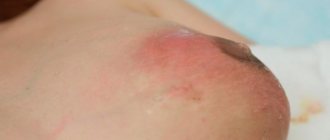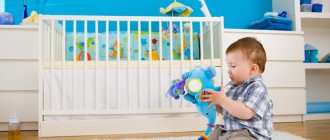Yellow diarrhea in a child is a sign of the development of a disease in the intestines. Diarrhea can be caused by improper digestion of food, poisoning, or taking medications. Loose stools in children require immediate treatment.
Causes
Yellow stool indicates an upset stomach. The causes of its appearance are divided into infectious and non-infectious.
Infectious:
- rotavirus;
- harmful bacteria;
- inflammation of the mucous membranes in the intestines.
Non-infectious:
- lactose intolerance;
- poisoning;
- taking medications, such as antibiotics;
- stress;
- intestinal inflammation;
- non-invasive infections.
In infants, changes in stool are often associated with the mother's diet. The cause of diarrhea if the baby is bottle-fed is an incorrectly prepared formula.
When the stool changes, accompanying symptoms appear that will help determine the exact cause of the yellow stool.
Symptoms
Diarrhea in children appears suddenly and is accompanied by visible symptoms. Diarrhea begins with seething in the stomach, pain, and the urge to go to the toilet becomes more frequent.
Associated symptoms:
- lack of appetite;
- the skin becomes pale;
- worsening mood, drowsiness;
- frequent loose stools;
- nausea;
- temperature increase.
Young children become capricious. The appearance of symptoms requires parents to provide first aid, and it is also necessary to call an ambulance.
Foamy yellow stool
Foamy stools indicate intoxication of the body caused by fatty, spicy foods. Diarrhea for less than 3 days is not dangerous and goes away on its own if you follow a diet.
Causes:
- dysbacteriosis;
- viral infection;
- helminthiasis;
- inflammation of the stomach;
- eating fatty, spicy foods.
In a newborn, diarrhea with foam appears due to failure to absorb breast milk or formula. During the complementary feeding period, a new product can cause changes in stool. Seeing a doctor requires the presence of pus and bloody spots in the stool.
Uninvited guests
It happens that the mother, while taking out the potty, notices helminths (worms) in the feces. Most often these are pinworms. They live in the lower sections of the small and large intestines. Infection (invasion) occurs when eggs or larvae of parasites enter the body. Most often they fall from dirty hands into the baby's mouth. Young children are especially susceptible to worms, since the protective functions of the gastrointestinal tract are not yet perfect. A baby can become infected at home, on a walk, in kindergarten through contact with outdoor shoes, the floor in the hallway, toys, common areas, picking up dirty objects, fiddling in the sandbox, touching animals.
Symptoms of helminthic infestation:
- salivation;
- nausea;
- decreased or increased appetite (the child constantly wants to eat);
- cramping pain around the navel or without a specific localization, which appears regardless of food intake;
- bowel disorders (diarrhea, constipation);
- itching around the anus;
- increased fatigue;
- frequent headaches or dizziness;
- paleness and blueness under the eyes;
- child chokes on food.
Temperature with loose stools
An increase in body temperature above 38 degrees Celsius with diarrhea indicates the presence of an infection in the baby’s body.
Causes:
- Rotavirus, which is accompanied by yellow stools and vomiting.
- Teething.
- Intestinal infections.
High temperature is accompanied by loss of strength and lack of appetite . If the use of antipyretics does not give the desired effect, it is recommended to consult a doctor to avoid dehydration.
Detect saboteurs
“Uninvited residents” must be identified and driven away, otherwise they will poison and weaken the child’s body. Helminth eggs are detected in the laboratory, but this diagnosis is quite difficult. The fact is that they do not appear in the stool every day, so it is advisable to take tests at least 3 days in a row. In case of an increased risk of infection - contact with street animals, the habit of putting objects or fingers in the mouth, biting nails - it is recommended to undergo an examination, which, in addition to a three-time stool test, includes a blood test for antibodies to helminths. If you find worms or suspect an infection, do not self-medicate. The antihelminthic drugs you buy may turn out to be not only ineffective, but even toxic.
Nausea and vomiting
Light yellow diarrhea and vomiting in a child may be due to exposure to an infectious disease, a cold. Symptoms affect the intestinal mucosa and lead to water imbalance.
What to pay attention to:
- weight loss;
- blood streaks in stool;
- rare urge to go to the toilet;
- dark yellow urine.
All signs indicate dehydration if they do not stop for more than a day. If signs of infection appear in a child under one year old, it is recommended to call an ambulance.
Causes of constipation
Constipation in an 8-month-old child can occur for the following reasons:
- insufficient drinking regime, as a result of which the stool thickens and becomes hard;
- introduction of foods into complementary foods that have a strengthening effect on stool;
- low content of coarse fiber in the diet;
- little physical activity of the baby;
- rectal fissure;
- lethargy of the digestive tract;
- stress factors;
- adhesions or tumor formations;
- helminthiasis;
- Hirschsprung's disease;
- allergic reactions, diathesis.
Frequent manifestation of pathology
Frequent diarrhea leads to dehydration. It is necessary to identify the cause of the condition and begin immediate treatment.
Why does frequent diarrhea occur in children?
- there is a violation of the intestines;
- there is lactose intolerance;
- infectious and cold diseases appeared.
Diarrhea for more than three days has an adverse effect on the child’s body and leads to dehydration.
Light yellow diarrhea in children under one year of age
A one-month-old baby's stool is bright yellow to light in color. This condition is not a pathology and no treatment is required.
Changes in stool in children under one year old, the appearance of an unpleasant odor, inclusions of mucus, are the causes of intestinal dysfunction. When taking antibiotics, the microflora changes.
Causes:
- feeding schedule is disrupted;
- dysbacteriosis;
- lactose intolerance;
- failure to follow instructions for preparing formula;
- teething;
- diseases of the intestines, liver;
- infections.
With dysbacteriosis, the stool is quite liquid and foamy. Normally, this phenomenon occurs in the first 3 weeks of a baby’s life . At 7 months, the first complementary foods are started, which can also cause diarrhea and yellowish stools.
Breastfeeding requires a woman to follow nutritional rules to avoid diarrhea in her baby. It is recommended to exclude legumes, fatty foods, fried foods, and carbonated drinks.
When to see a doctor:
- The baby constantly cries and kicks his legs.
- The baby refuses to eat.
- Mucus and streaks of blood appear in the stool.
- Heat.
- Skin tone changes.
Prevention of diarrhea in infants includes the diet of the nursing mother and the rules for introducing complementary foods. All food products are thoroughly washed and, if possible, treated thermally.
Constipation and its symptoms
Constipation is considered to be the absence of bowel movements for two days or more, or difficult, irregular bowel movements, characterized by straining, pain, and hard stool.
Normally, an 8-month-old baby should walk “big” 1-2 times a day, but we must not forget about rare exceptions when, due to the physiological characteristics of the child, stool is observed once every two days. However, even with regular bowel movements, you need to pay attention to the type of feces: dry, formed in the form of individual lumps stuck together or dark-colored sheep feces - this is the main sign of constipation.
In addition, the baby may have abdominal pain that goes away after bowel movements. Fresh blood may appear, indicating microtrauma of the rectum. Some children push hard without any result. Sometimes vomiting occurs.
Constipation must be treated. In some cases, it goes away on its own, but most often parents are required to take action so as not to start the problem and not to aggravate it.
Treatment methods
Treatment of yellow diarrhea begins with determining the cause of its appearance. They use medications, folk remedies, and diet.
First aid for diarrhea:
- drink more clean water;
- monitor body temperature;
- eat in small portions;
- give sorbent.
You cannot force a child to eat if he has no appetite. If the temperature rises, you need to give your baby an antipyretic.
Medications
Diarrhea medications:
- Sorbents: Smecta, Activated carbon, Enterosgel. Aimed at removing toxins.
- Probiotics: Bifidumbacterin, Acipol, Bifiform, Enterol. Restore intestinal microflora.
- Antihistamines: Zodak, Cetrin. Used for food allergic reactions.
- Enzymes: Creon, Pancreatin. Improves liver function.
Medicines are used as prescribed by the attending physician.
Traditional medicine methods
Folk remedies for diarrhea:
- Rice water. Rice is boiled in water. The broth is filtered and given warm to children: up to one year - 1 tablespoon, after one year - 100 ml three times a day.
- Water-salt solution. For a glass of boiled water: 20 grams of sugar, 10 grams of salt. Give your child a tablespoon of tincture every 15 minutes. Allowed for newborns.
- Oak bark. Pour boiling water over a tablespoon of bark and leave for half an hour. The strained broth is used for enemas.
The use of folk remedies, as well as medications, requires consultation with a doctor.
Nutrition correction
Food for diarrhea should be light, not greasy. Chicken broth with breadcrumbs is considered the best. The dish does not irritate the intestines, but at the same time saturates the body.
Diet rules for diarrhea:
- For babies, you need to reduce the number of feedings.
- Children from 2 years old are fed in small portions.
- Increase the water intake.
- Dishes are prepared by steaming.
- Exclude fresh fruits and vegetables and dairy products from the diet.
- It is forbidden to eat fried, spicy, smoked food.
The diet allows you to improve intestinal function and relieve irritation.
Treatment of constipation
If an 8-month-old child has constipation, what should I do? Treatment is primarily aimed at eliminating the root cause. In the case of congenital and acquired forms of hemorrhoids, the surgical method is usually used. But in the overwhelming majority, the cause of constipation is digestive disorders, which is easily explained in the case of children 8 months old. Usually the problem is caused by a specific food and fluid deficiency. These factors need to be eliminated first.
Acute constipation is quite difficult for children, with pain, crying and anxiety. Here, parents must take measures to alleviate the condition of the baby. Helpful:
- Cleansing enema with boiled water at room temperature. For an 8-month-old child, it is enough to inject 50–100 ml into the anus. water and after a few minutes let the child have a bowel movement. You can add 1 spoon of glycerin solution or chamomile decoction to the water you use.
- Glycerin suppositories for children. Their use is permissible from infancy, but it is necessary to administer not the entire suppository, but ¼ or 1/3 of it. After administration, you need to wait a few minutes and then put the baby on the potty.
- Abdominal massage. Without exception, all pediatric gastroenterologists talk about its benefits for children of all ages. During the massage, movements should be circular and performed clockwise, or unilateral along the line of the oblique abdominal muscles. It is useful to perform the exercise by pressing the bent legs to the stomach, while controlling the pressure. Such simple actions activate intestinal motility and promote the movement of feces towards the exit.
- Microclysters "Microlax" have already been appreciated by many mothers. This drug has a convenient form in the form of a tube with a long tip, the contents of which (5 ml) are administered to the baby. The result can be expected within an hour. The only correction: Microlax can cause a feeling of discomfort and burning in the anus for many people, including children. Therefore, it should be used as a last resort and on the recommendation of a doctor.
If your child's constipation becomes regular, the doctor will prescribe medication.
Drug treatment of constipation
The most popular remedy for constipation is Duphalac. It can be given to the child in the form of syrup, diluted with a small amount of water. The drug is based on the action of lactulose (a derivative of milk sugar), which is broken down by beneficial intestinal bacteria, promoting their active growth. As a result of intake, the feces soften, increase in volume and easily pass out. Duphalac has a cumulative effect, so results should be expected in 3-7 days. Indicated for children under one year of age.
Forlax is a drug for constipation in a sachet form for children. Its action is based on the accumulation of water in the feces, as a result of which they soften, and increased intestinal motility facilitates their easy removal from the body. The drug is not absorbed by the intestinal walls, is not addictive, and is indicated for children from 6 months.
Probiotics: Acipol, Linex, Primadophilus, Biobakton, Normobakt L - all these are live lactobacilli bacteria, which, once in the digestion, begin active enzymatic and phagocytic activity. Their action helps eliminate dysbiosis and improve digestion in general.
Enzymes: Creon 10000, Mezim Forte - designed to improve the enzyme function of the pancreas and, accordingly, improve food digestion. The drug is indicated for diseases accompanied by constipation, as well as in the complex treatment of dysbiosis, colic and constipation. Allowed for children under one year old. Reception should be carried out under the supervision of a doctor.
Choleretic drugs such as Hofitol are prescribed for dysfunction of the gallbladder, which often causes a side effect in the form of constipation. The drug Hofitol of plant origin in the form of drops for infants. It has a choleretic and mild diuretic effect. Indicated for children from birth.
Treatment with traditional methods
Many mothers prefer to cope with constipation in their children with the help of their grandmother’s natural recipes. When you give your baby such remedies, the effect may not occur immediately, but within a few days. You need to be prepared for this. Proven methods in this case are:
- Unsweetened dried fruit compote, especially prunes and dried apricots. It is given little by little, 50 ml in between meals. The remaining berry mixture can be crushed and given to the child as a dessert.
- Dill water, known to everyone as an effective remedy for gas formation in a child’s tummy. It helps well with constipation accompanied by flatulence. A child of 8 months can drink up to 1 glass per day.
- Beetroot juice, 1 teaspoon at night, in the absence of allergies, helps well against stagnation of feces.
- Sprouted wheat grains are a valuable source of easily absorbed vitamins and minerals. The fiber contained in grains is a great way to restore bowel function. For children 8 months old, wheat is crushed and given 1 teaspoon along with their main food.
Mandatory diet for constipation
This condition in all people without exception, including 8-month-old babies, is treated with a special diet. Moreover, when breastfeeding, it is advisable to maintain the diet for the nursing mother, replacing protein foods with foods with coarse fiber. The baby's nutrition must be maintained with a sufficient volume of fluid per 1 kg. body 40 ml. water.
The digestion of an 8-month-old baby continues to develop. At this age, he receives complementary foods, and the diet is replenished with new products every week. During such a period, it is very important to exercise strict control over the child’s nutrition, and introduce all foods strictly according to established standards.
Do not overfeed your baby with complementary foods! Breast milk or formula should continue to be his primary food. If constipation does occur, you should first of all remove constipating foods from your diet, such as:
- rice cereal;
- banana;
- potato;
- flour products.
The diet should contain a sufficient amount of dietary fiber, which is known for its cleansing effect on the intestines. Therefore, the diet should include vegetable and fruit purees: apple, peach, apricot, plum, as well as broccoli, cauliflower and zucchini. All this must be combined with a sufficient amount of liquid.
If a child eats porridge prepared with cow's milk, then it is better to remove the latter for now. But you can introduce fermented milk products, such as cottage cheese, yogurt and kefir, and also prepare light vegetable soups. At this stage, you cannot stop breastfeeding or change the formula!
Possible complications if left untreated
Complications:
- dehydration;
- convulsions;
- stomach upset;
- sepsis;
- encephalitis, anemia.
If diarrhea is severe and left untreated, death is possible.
What to do to prevent relapses
To prevent recurrence of diarrhea, it is recommended:
- observe the rules of personal hygiene;
- prepare the milk mixture according to the instructions;
- Feed children only fresh foods.
- monitor your water balance.
Preventive measures will help avoid relapses and reduce the load on the intestines.
Yellow diarrhea in children of any age causes concern for parents. If, in addition to diarrhea, the temperature rises, vomiting and lethargy appear, this indicates an infection and requires the help of a doctor. Sorbents, probiotics, and antihistamines are used for treatment.











